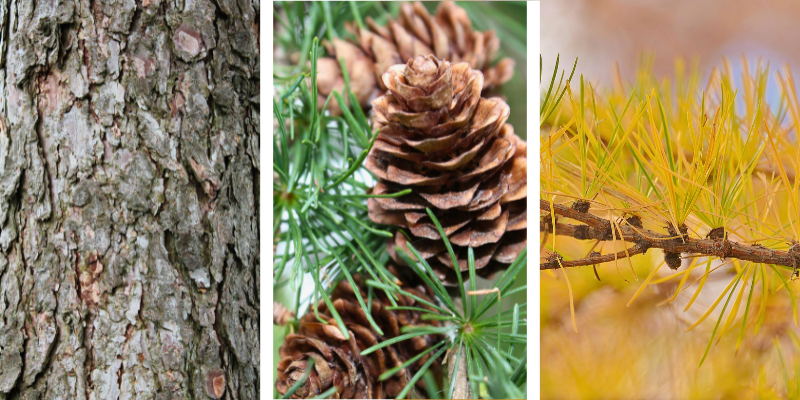
The tamarack tree (Larix laricina) is a member of the larch genus (Larix) and is also known as hackmatack, American larch, Eastern larch and black or red larch. The specific epithet of its botanical name (laricina) means “larch-like” and comes from the Latin “larigna”, named after the ancient settlement of Larignum in the European Alps. The story goes that in 58 BC, Julius Caesar’s legion set a wooden tower ablaze in Larignum, but to his dismay, the tower remained standing. Caesar named the tree that the wood beams came from larch to honour the town’s name and resilience. Today, wood from larches like the tamarack are still preferred in construction.
The common name tamarack or hackmatack is believed to be derived from an Algonquian word, possibly referring to wood traditionally used for snowshoes.
A Deciduous Conifer
The term deciduous describes trees like maples and oaks that shed their typically broad leaves in autumn. In contrast, evergreen is a term describing trees like pines and spruces that hold onto their needle or scale-like leaves year-round. Most evergreens are also coniferous, meaning they are cone-bearing seed trees. Because of these general patterns, most people assume that trees are either broadleaf deciduous without cones or evergreen with cones.
What makes the tamarack tree so unique? It is a deciduous conifer—an unusual combination in the tree world! Unlike most conifers that keep their needles year-round, the tamarack’s needles turn a beautiful golden yellow each autumn before falling, creating a striking seasonal show.
A Widespread Charm
Tamaracks have a large geographic range, growing in every province and territory in Canada. They tolerate a broad spectrum of conditions, from the harsh winters of Arctic Yukon to the hot summers of Southern Ontario. While they naturally thrive in sunny, wet areas, they also do well in well-drained sandy soils.

Reaching an average mature height of fifty feet in urban environments, the tamarack has a straight and slender trunk, with scaly, reddish-brown mature bark. In spring, light, flat green needles appear on the branches, complementing the pink-red scales of newly developing cones. In late summer, the mature brown, egg-shaped cones open and then persist on the tree as its needles turn golden and begin to fall in autumn.
An Ecological Cornerstone
The tamarack is a valuable resource for many ecosystems. Its small seeds feed birds such as red crossbills and small mammals like chipmunks and squirrels. The tree also provides valuable nesting habitat for songbirds like sparrows and warblers.

Why Plant a Tamarack Tree?
The tamarack is an excellent choice for anyone looking to add a touch of the wild to their property. Its striking fall colour and value to wildlife make it a great addition to the right yard. Plus, it’s a conversation starter—how often do you see a conifer that loses its needles?
Are you ready to add a native tree to your yard? Check out our Backyard Tree Planting Program and let our experts guide you in selecting your next tree.
Jon is an ISA certified arborist and is a former Residential Planting Programs Senior Field Coordinator at LEAF
LEAF offers a subsidized Backyard Tree Planting Program for private property. The program is supported by the City of Toronto, the Regional Municipality of York, the City of Markham, the Town of Newmarket, the City of Vaughan, the Regional Municipality of Durham, the Town of Ajax, the Municipality of Clarington, the City of Oshawa, the City of Pickering, the Township of Scugog and the Town of Whitby.
